8. Sensorless Control of Permanent Magnet Synchronous Motor Assignment 2022
Added on 2022-10-11
71 Pages12072 Words20 Views
1
SENSORLESS CONTROL OF PERMANENT MAGNET SYNCHRONOUS MOTOR.
ABSTRACT.
Electric motors are being used in different ways and applications ranging from general purpose
where they are used to power some household equipment, machine tools and to industrial scale
where they are used as a driving force in industrial facilities. Nonetheless, the function and
performance efficiency needed from these motors vary depending on the application and level of
production. In this case, it necessitates for both torque and speed control of the motors for
execution of intendent operation. Permanent Magnet Synchronous Motor is the type of motor
that can be controlled by using different sensor control mechanism. There is different permanent
magnet synchronous motor sensor mechanism discussed in the same report. They include; zero
voltage vector injection, voltage/frequency control, back EMF method, average terminal voltage,
rotor position estimation method, and Halbach array. The latter, Halbach array method, have
been dealt with in details expounding on its superiority against other methods. Facts and figures
have been used to cement the conclusion.
Table of Contents
SENSORLESS CONTROL OF PERMANENT MAGNET SYNCHRONOUS MOTOR.
ABSTRACT.
Electric motors are being used in different ways and applications ranging from general purpose
where they are used to power some household equipment, machine tools and to industrial scale
where they are used as a driving force in industrial facilities. Nonetheless, the function and
performance efficiency needed from these motors vary depending on the application and level of
production. In this case, it necessitates for both torque and speed control of the motors for
execution of intendent operation. Permanent Magnet Synchronous Motor is the type of motor
that can be controlled by using different sensor control mechanism. There is different permanent
magnet synchronous motor sensor mechanism discussed in the same report. They include; zero
voltage vector injection, voltage/frequency control, back EMF method, average terminal voltage,
rotor position estimation method, and Halbach array. The latter, Halbach array method, have
been dealt with in details expounding on its superiority against other methods. Facts and figures
have been used to cement the conclusion.
Table of Contents
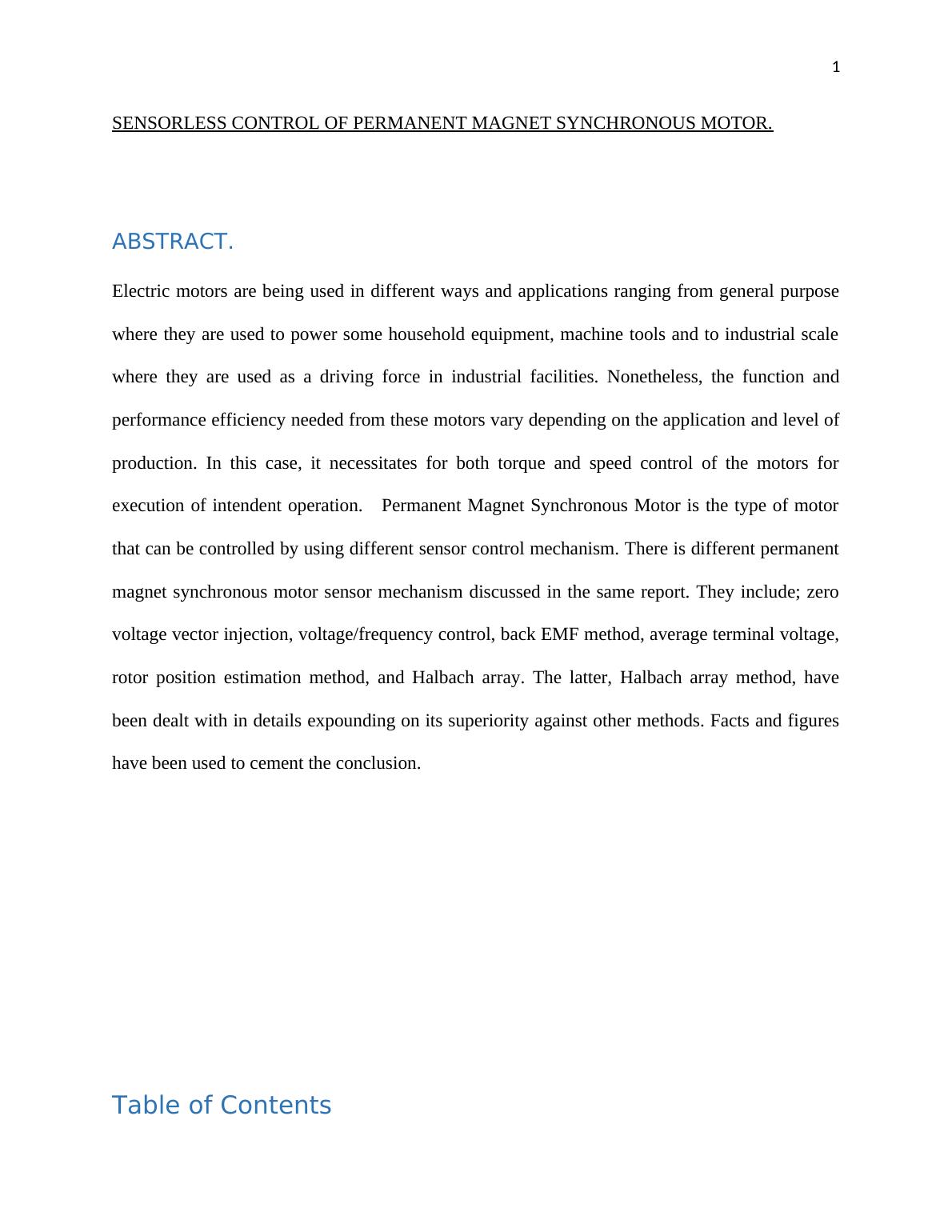
2
ABSTRACT.................................................................................................................. 1
LIST OF FIGURES......................................................................................................... 4
ABBREVIATIONS.......................................................................................................... 7
CHAPTER ONE: INTRODUCTION.................................................................................. 8
1.1 : DC motors.................................................................................................... 8
1.2: AC motor.......................................................................................................... 9
1.2.1 : Induction motors........................................................................................ 10
1.2.2 : Synchronous motors...................................................................................10
CHAPTER TWO : PERMANENT MAGNET SYNCHRONOUS MOTOR..............................11
1.1 : Construction of the PMSM..........................................................................11
1.2 : Permanent magnet synchronous motor’s correspondent circuit in D-Q axis.
13
1.3 : Operational Principle of permanent Magnet Synchronous Machine (PMSM).
16
CHAPTER 3: METHODS OF CONTROLLING PMSM......................................................17
3.1: Zero voltage vector injection.........................................................................18
3.1.1: Mathematical exploration of rotor position approximation assessment when
subjected to Zero voltage vector..........................................................................19
3.2 : Voltage Frequency Control...................................................................21
3.3 : Back E.M.F Control................................................................................. 24
3.3.1 : Back EMF estimation model in mathematics for PMSM............25
3.3.2 : Exhibiting in a stationary reference frame,.......................................26
ABSTRACT.................................................................................................................. 1
LIST OF FIGURES......................................................................................................... 4
ABBREVIATIONS.......................................................................................................... 7
CHAPTER ONE: INTRODUCTION.................................................................................. 8
1.1 : DC motors.................................................................................................... 8
1.2: AC motor.......................................................................................................... 9
1.2.1 : Induction motors........................................................................................ 10
1.2.2 : Synchronous motors...................................................................................10
CHAPTER TWO : PERMANENT MAGNET SYNCHRONOUS MOTOR..............................11
1.1 : Construction of the PMSM..........................................................................11
1.2 : Permanent magnet synchronous motor’s correspondent circuit in D-Q axis.
13
1.3 : Operational Principle of permanent Magnet Synchronous Machine (PMSM).
16
CHAPTER 3: METHODS OF CONTROLLING PMSM......................................................17
3.1: Zero voltage vector injection.........................................................................18
3.1.1: Mathematical exploration of rotor position approximation assessment when
subjected to Zero voltage vector..........................................................................19
3.2 : Voltage Frequency Control...................................................................21
3.3 : Back E.M.F Control................................................................................. 24
3.3.1 : Back EMF estimation model in mathematics for PMSM............25
3.3.2 : Exhibiting in a stationary reference frame,.......................................26
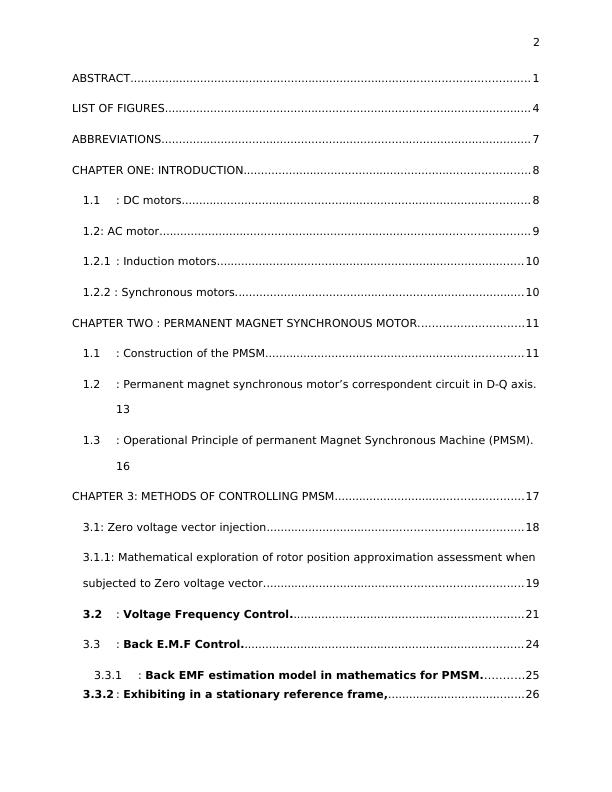
3
3.3.3: Mathematical prototyping in the rotor reference frame...............28
3.4 : Average Terminal Voltage Sensorless PMSM Control.................................31
3.4.1 : Principle of average terminal voltage operation on the rectangular
commutation...................................................................................................... 32
3.4.2 : Principle of average terminal voltage operation on the sinusoidal
commutation...................................................................................................... 36
3.4.3 : Position interpolation and compensation....................................37
3.5 : ‘Initial Rotor Position Estimation Method’..................................................38
3.5.1 : The saturation saliency principle effect...............................................39
3.5.2 : Mathematical prototype of a SPMSM with saturation
characteristics................................................................................................ 41
CHAPTER FOUR: HALBACH ARRAY METHOD.............................................................43
4.1 : How Halbach array work...........................................................................43
4.2 : Circumferential arrays of magnetic orientation...................................43
4.3 : Halbach Cylinders and related circular Halbach arrays......................44
4.4: Planar Halbach Arrays............................................................................... 44
4.5: Halbach array application in the PMSM..................................................45
4.6 : Mathematical Prototype of The Halbach Array....................................49
4.7 : Flux density of the air gap....................................................................49
4.7.1 : Top layer’s magnetic field..............................................................51
4.7.2 : Bottom layer’s magnetic field.......................................................52
4.7.3 The Electromagnetic Thrust and Back EMF...................................52
4.8 : Limitations of Using Other Methods...................................................53
4.8.1 : Disadvantage of the Average terminal voltage..........................53
4.8.2 : Disadvantages of the rotor position estimation method..........54
4.9 : Advantages of Halbach array method................................................55
4.10 Case Study.................................................................................................... 55
3.3.3: Mathematical prototyping in the rotor reference frame...............28
3.4 : Average Terminal Voltage Sensorless PMSM Control.................................31
3.4.1 : Principle of average terminal voltage operation on the rectangular
commutation...................................................................................................... 32
3.4.2 : Principle of average terminal voltage operation on the sinusoidal
commutation...................................................................................................... 36
3.4.3 : Position interpolation and compensation....................................37
3.5 : ‘Initial Rotor Position Estimation Method’..................................................38
3.5.1 : The saturation saliency principle effect...............................................39
3.5.2 : Mathematical prototype of a SPMSM with saturation
characteristics................................................................................................ 41
CHAPTER FOUR: HALBACH ARRAY METHOD.............................................................43
4.1 : How Halbach array work...........................................................................43
4.2 : Circumferential arrays of magnetic orientation...................................43
4.3 : Halbach Cylinders and related circular Halbach arrays......................44
4.4: Planar Halbach Arrays............................................................................... 44
4.5: Halbach array application in the PMSM..................................................45
4.6 : Mathematical Prototype of The Halbach Array....................................49
4.7 : Flux density of the air gap....................................................................49
4.7.1 : Top layer’s magnetic field..............................................................51
4.7.2 : Bottom layer’s magnetic field.......................................................52
4.7.3 The Electromagnetic Thrust and Back EMF...................................52
4.8 : Limitations of Using Other Methods...................................................53
4.8.1 : Disadvantage of the Average terminal voltage..........................53
4.8.2 : Disadvantages of the rotor position estimation method..........54
4.9 : Advantages of Halbach array method................................................55
4.10 Case Study.................................................................................................... 55
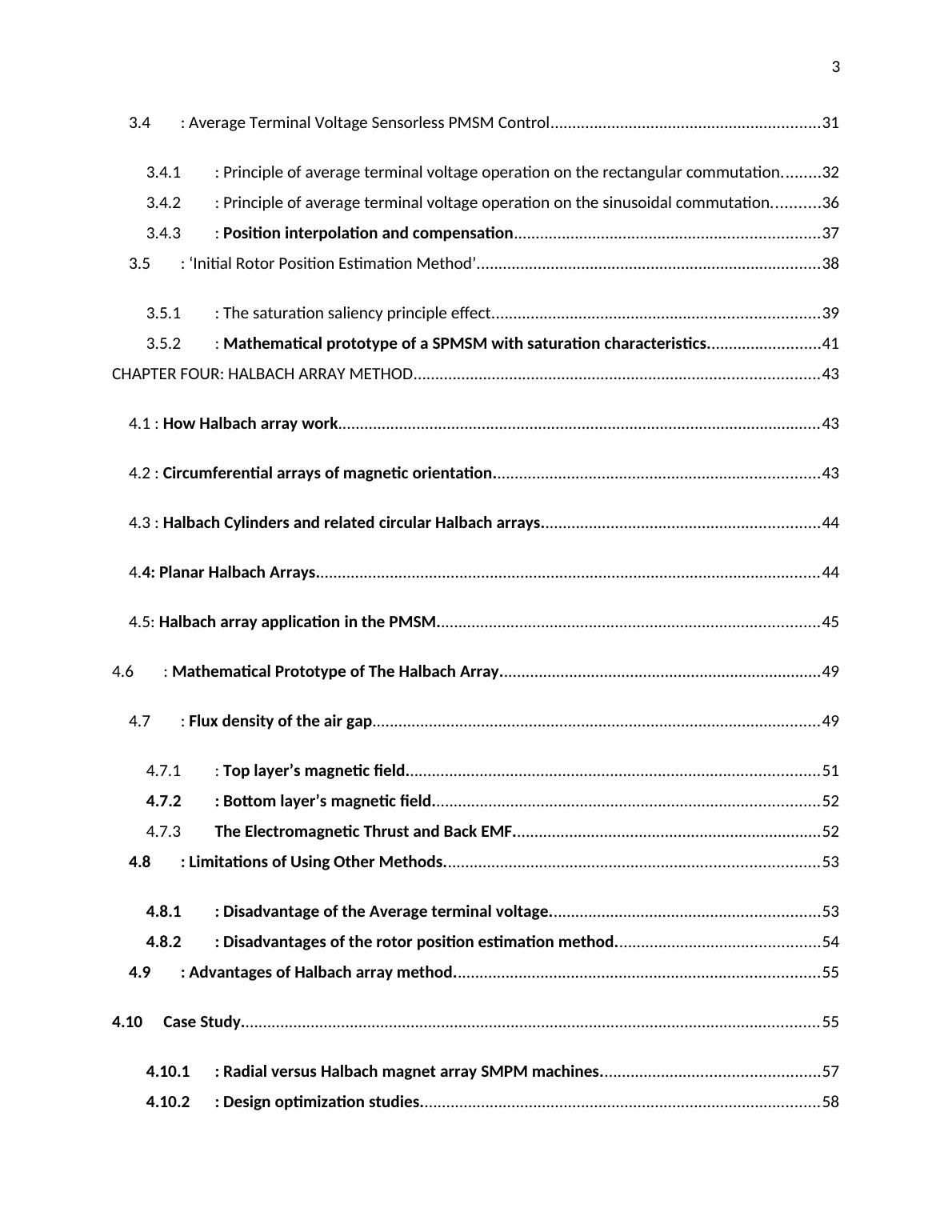
4
4.10.1 : Radial versus Halbach magnet array SMPM machines.............57
4.10.2 : Design optimization studies..........................................................58
CHAPTER FIVE: CONCLUSION................................................................................... 61
REFERENCES............................................................................................................ 62
LIST OF FIGURES
Figure 1: Surface Mount Permanent Magnet Synchronous Motor (PMSM) (Credit:Electrical Concepts,
2018)......................................................................................................................... 11
Figure 2: Interior Permanent Magnet Synchronous Motor (IPMSM). ) (Credit:Electrical Concepts,
2018)......................................................................................................................... 12
Figure 3: The correspondent circuit model of the PMSM in the D-axis. Credit; (Dehkordi et al., 2019).
................................................................................................................................. 13
Figure 4: The equivalent circuit of the PMSM in the Q-axis Credit; (Dehkordi et al., 2019)............13
Figure 5: Thevenin equivalent circuit of the PMSM in D-axis. Credit; (Dehkordi et al., 2019).........15
4.10.1 : Radial versus Halbach magnet array SMPM machines.............57
4.10.2 : Design optimization studies..........................................................58
CHAPTER FIVE: CONCLUSION................................................................................... 61
REFERENCES............................................................................................................ 62
LIST OF FIGURES
Figure 1: Surface Mount Permanent Magnet Synchronous Motor (PMSM) (Credit:Electrical Concepts,
2018)......................................................................................................................... 11
Figure 2: Interior Permanent Magnet Synchronous Motor (IPMSM). ) (Credit:Electrical Concepts,
2018)......................................................................................................................... 12
Figure 3: The correspondent circuit model of the PMSM in the D-axis. Credit; (Dehkordi et al., 2019).
................................................................................................................................. 13
Figure 4: The equivalent circuit of the PMSM in the Q-axis Credit; (Dehkordi et al., 2019)............13
Figure 5: Thevenin equivalent circuit of the PMSM in D-axis. Credit; (Dehkordi et al., 2019).........15

5
Figure 6: Vector illustration of the Permanent Magnet Synchronous Motor Voltage Frequency Control.
Credit (Tu et al., 2017)............................................................................................... 21
Figure 7: Voltage Frequency control with stabilization feedback structure. Credit (Tu et al., 2017). 22
Figure 8: Back EMF sensorless based functional block Credit (Jung-Ik H, 2012)............................24
Figure 9: Space vector diagram of the permanent magnet synchronous motor. Credit (Jung-Ik H, 2012).
................................................................................................................................. 25
Figure 10: Cheap Sensorless commutation signal generator. Credit (Chen, Tai and Cheng, 2019).
................................................................................................................................. 30
Figure 11: Output of the signal generator. Credit (Chen, Tai and Cheng, 2019)......................31
Figure 12: Equivalent topology of the PMSM inverter circuit. Credit (Chen, Tai and Cheng, 2019).
................................................................................................................................. 32
Figure 13: Back EMF and Excitation current of the PMSM. Credit (Chen, Tai and Cheng, 2019).
................................................................................................................................. 32
Figure 14: Ideal back EMF, average line voltage and line to line voltages with their phase angle
relationship. Credit (Chen, Tai and Cheng, 2019)...........................................................34
Figure 15: Low Pass filter. Credit (Chen, Tai and Cheng, 2019).........................................37
Figure 16: The dependency between current on the stator winding and d-axis inductance. Credit (Wu et
al., 2019).................................................................................................................... 39
Figure 17: D-axis magnetic curve characteristic curve. Credit (Wu et al., 2019)............................39
Figure 18: The schematic model of the synchronous motor with Surface mounted permanent magnet in
coordinate form. Credit (Wu et al., 2019)............................................................................40
Figure 19: Circumferential magnetic field aligned through the Alnico horseshoe.............................42
Figure 20: Magnetic field in Planar Halbach Array. Credit (Dura Magnetics, 2019).......................44
Figure 21: Halbach magnet array........................................................................................ 45
Figure 22: The magnetic field flux line in the Halbach array motor. Credit (Murat et al., 2016).....45
Figure 6: Vector illustration of the Permanent Magnet Synchronous Motor Voltage Frequency Control.
Credit (Tu et al., 2017)............................................................................................... 21
Figure 7: Voltage Frequency control with stabilization feedback structure. Credit (Tu et al., 2017). 22
Figure 8: Back EMF sensorless based functional block Credit (Jung-Ik H, 2012)............................24
Figure 9: Space vector diagram of the permanent magnet synchronous motor. Credit (Jung-Ik H, 2012).
................................................................................................................................. 25
Figure 10: Cheap Sensorless commutation signal generator. Credit (Chen, Tai and Cheng, 2019).
................................................................................................................................. 30
Figure 11: Output of the signal generator. Credit (Chen, Tai and Cheng, 2019)......................31
Figure 12: Equivalent topology of the PMSM inverter circuit. Credit (Chen, Tai and Cheng, 2019).
................................................................................................................................. 32
Figure 13: Back EMF and Excitation current of the PMSM. Credit (Chen, Tai and Cheng, 2019).
................................................................................................................................. 32
Figure 14: Ideal back EMF, average line voltage and line to line voltages with their phase angle
relationship. Credit (Chen, Tai and Cheng, 2019)...........................................................34
Figure 15: Low Pass filter. Credit (Chen, Tai and Cheng, 2019).........................................37
Figure 16: The dependency between current on the stator winding and d-axis inductance. Credit (Wu et
al., 2019).................................................................................................................... 39
Figure 17: D-axis magnetic curve characteristic curve. Credit (Wu et al., 2019)............................39
Figure 18: The schematic model of the synchronous motor with Surface mounted permanent magnet in
coordinate form. Credit (Wu et al., 2019)............................................................................40
Figure 19: Circumferential magnetic field aligned through the Alnico horseshoe.............................42
Figure 20: Magnetic field in Planar Halbach Array. Credit (Dura Magnetics, 2019).......................44
Figure 21: Halbach magnet array........................................................................................ 45
Figure 22: The magnetic field flux line in the Halbach array motor. Credit (Murat et al., 2016).....45
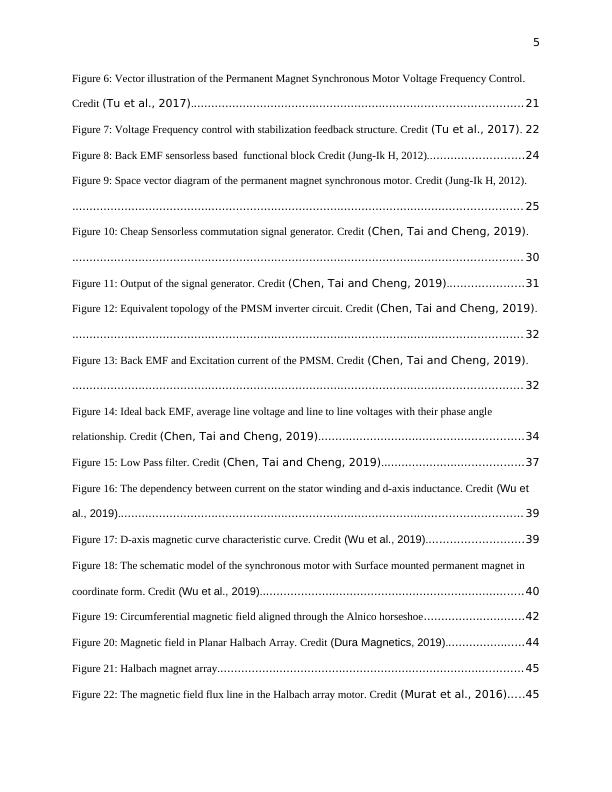
6
Figure 23: Figure 23: . Flux distribution in Halbach magnet array synchronous
motor. Credit (Murat et al., 2016)............................................................................. 46
Figure 24: Magnetic field orientation in Halbach cylinder. Credit (Collins, 2018)............................47
Figure 25: Figure 25: Double-sided Halbach permanent magnet array. Credit (Zhang, Kou and Liu, 2019).
................................................................................................................................. 48
Figure 26: Figure 26: The analytical scheme of “Ironless Linear Synchronous motor with novel” Halbach
permanent magnet. a) Overview, b) Top layer, c) bottom layer. Credit (Zhang, Kou and Liu, 2019).....49
Figure 27: Figure 27: The cross section of the stator’s three phase windings. Credit (Zhang, Kou and Liu,
2019).......................................................................................................................... 52
Figure 28: The magnetization direction on radial SMPM machine. Credit (Murat et al., 2016)............56
Figure 29: The graphical representation of the Pareto results. Credit (Murat et al., 2016)...................58
Figure 30: The results of simulation. Credit (Murat et al., 2016).................................................59
Figure 23: Figure 23: . Flux distribution in Halbach magnet array synchronous
motor. Credit (Murat et al., 2016)............................................................................. 46
Figure 24: Magnetic field orientation in Halbach cylinder. Credit (Collins, 2018)............................47
Figure 25: Figure 25: Double-sided Halbach permanent magnet array. Credit (Zhang, Kou and Liu, 2019).
................................................................................................................................. 48
Figure 26: Figure 26: The analytical scheme of “Ironless Linear Synchronous motor with novel” Halbach
permanent magnet. a) Overview, b) Top layer, c) bottom layer. Credit (Zhang, Kou and Liu, 2019).....49
Figure 27: Figure 27: The cross section of the stator’s three phase windings. Credit (Zhang, Kou and Liu,
2019).......................................................................................................................... 52
Figure 28: The magnetization direction on radial SMPM machine. Credit (Murat et al., 2016)............56
Figure 29: The graphical representation of the Pareto results. Credit (Murat et al., 2016)...................58
Figure 30: The results of simulation. Credit (Murat et al., 2016).................................................59
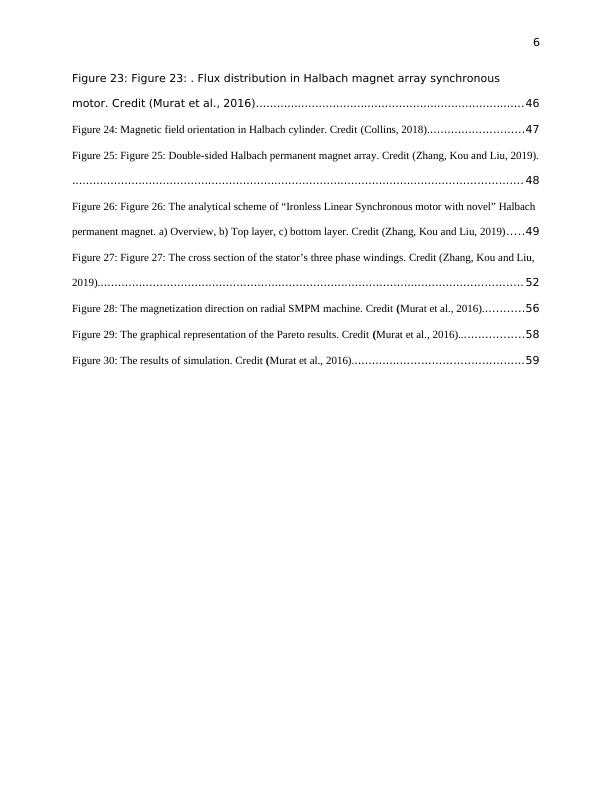
7
ABBREVIATIONS.
AC Alternating Current.
DC Direct Current.
EMF Electromotive Force.
ILSM Ironless Linear Synchronous Motor.
IPMSM Interior Permanent Magnet Synchronous Motor.
HPF High Pass Filter.
Matlab Matrix Laboratory.
SPMSM Surface Permanent Magnet Synchronous Motor.
SPWM Sinusoidal Pulse Width Modulation.
SVPWM Sinusoidal Voltage Pulse Width Modulation
PMSM Permanent Magnet Synchronous Motor.
ABBREVIATIONS.
AC Alternating Current.
DC Direct Current.
EMF Electromotive Force.
ILSM Ironless Linear Synchronous Motor.
IPMSM Interior Permanent Magnet Synchronous Motor.
HPF High Pass Filter.
Matlab Matrix Laboratory.
SPMSM Surface Permanent Magnet Synchronous Motor.
SPWM Sinusoidal Pulse Width Modulation.
SVPWM Sinusoidal Voltage Pulse Width Modulation
PMSM Permanent Magnet Synchronous Motor.

8
CHAPTER ONE: INTRODUCTION
Electric motor is defined as the electromechanical machine which operates on electrical power to
convert electrical power into mechanical rotational power. The realization of mechanical
rotational energy is achieved by the mutual collaboration of two magnetic fields namely;
electrical field and magnetic field (Circuit Globe, 2019).
Collaboration of magnetic field and electric field results to force that actuates the rotor
components to rotate. The motors are structured with alternating polarities of the magnets in
nested rings. The field on the rotor rotates while the field on the stator components is stationary.
For continuous rotation of the rotor, then the north-south polarities of the electromagnets should
be reversing consistently (Dotson, 2018).
Basing on the type of electrical current used, electrical motors are broadly classified as AC
motors and DC motors (Circuit Globe, 2019).
However, there exist universal motors which are mainly single-phase series motors that use
either direct current or alternating current. These universal motors bear same characteristics as of
both DC and AC motors (Johnson Electric, 2019).
1.1 : DC motors.
These type of motors are classified according the ways windings are mounted. In the field of
electrical machines technology, there exist three basic classifications of DC motors namely;
series DC motor,
shunt DC motor
compound DC motor
CHAPTER ONE: INTRODUCTION
Electric motor is defined as the electromechanical machine which operates on electrical power to
convert electrical power into mechanical rotational power. The realization of mechanical
rotational energy is achieved by the mutual collaboration of two magnetic fields namely;
electrical field and magnetic field (Circuit Globe, 2019).
Collaboration of magnetic field and electric field results to force that actuates the rotor
components to rotate. The motors are structured with alternating polarities of the magnets in
nested rings. The field on the rotor rotates while the field on the stator components is stationary.
For continuous rotation of the rotor, then the north-south polarities of the electromagnets should
be reversing consistently (Dotson, 2018).
Basing on the type of electrical current used, electrical motors are broadly classified as AC
motors and DC motors (Circuit Globe, 2019).
However, there exist universal motors which are mainly single-phase series motors that use
either direct current or alternating current. These universal motors bear same characteristics as of
both DC and AC motors (Johnson Electric, 2019).
1.1 : DC motors.
These type of motors are classified according the ways windings are mounted. In the field of
electrical machines technology, there exist three basic classifications of DC motors namely;
series DC motor,
shunt DC motor
compound DC motor
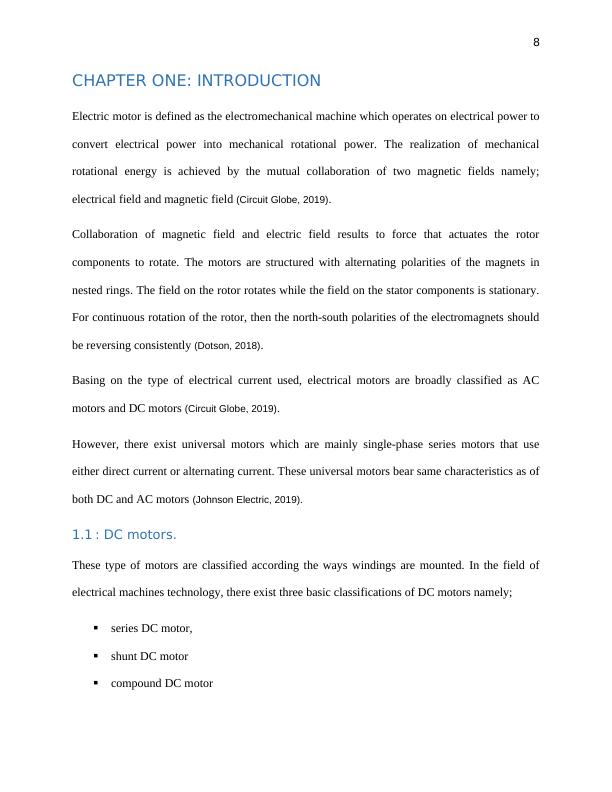
End of preview
Want to access all the pages? Upload your documents or become a member.
